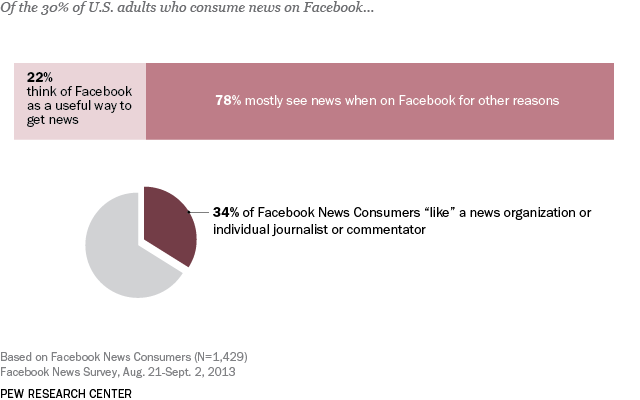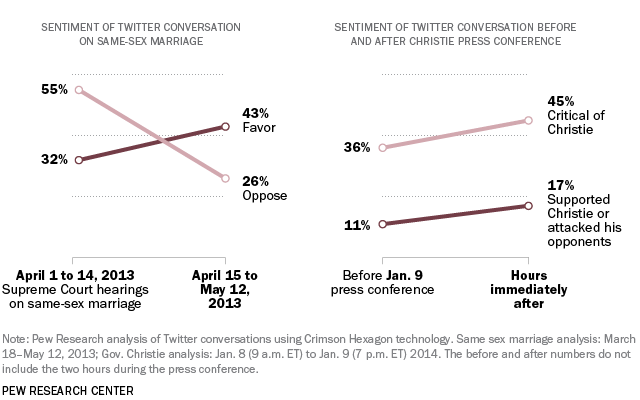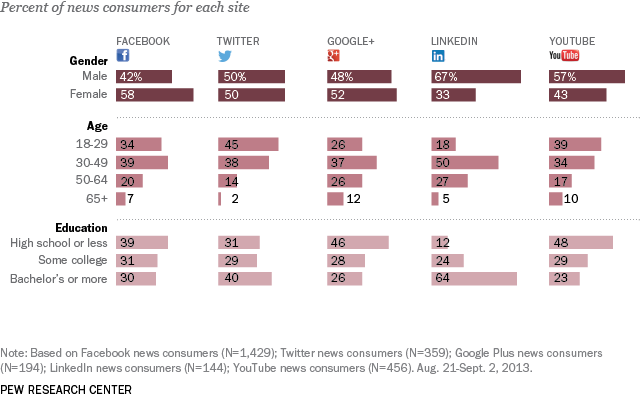As news organizations work to understand how consumers interact with digital news, the Pew Research Center’s Journalism Project, in collaboration with the John S. and James L. Knight Foundation, delved into how news is functioning in the social media space. Here, Pew Research pulls together eight key takeaways on what we learned in 2013 and early 2014 about social media and news.
1News has a place in social media – but on some sites more than others.
- Half of Facebook and Twitter users get news on those sites as do 62% of reddit users. But only a minority of those on Instagram or Pinterest finds news there.
- At this point, Facebook reaches far more Americans than any other social media site – and therefore allows for the most in-depth study. Overall, three in ten adults get at least some news while on Facebook.

2Getting “news” on Facebook is an incidental experience.
- 78% of Facebook news users mostly see news when on Facebook for other reasons.
- Just 34% of Facebook news consumers “like” a news organization or individual journalist, which suggests that the news they see there is coming from friends – the same friends likely sending them posts about …everything else.

3The range of news topics on Facebook is broad.
- Entertainment news tops the list of topics Facebook news consumers report seeing. This is followed by ‘people and events in my community’, sports, national government and politics, crime, health and medicine, and local government and politics.

4Engagement with the news plays a key role in the social media news experience.
- Not only are social network users sharing news stories, but, particularly with the growth in mobile devices, a certain portion is contributing to the reporting by taking photos or videos.

5On Twitter, groups of people come together around news events they feel passionately about. But opinions expressed on Twitter often differ from broad public opinion.
- In the days following the shootings in Newton, Conn., in 2012, nearly two-thirds of the statements on Twitter called for stricter gun control measures while public opinion was far more evenly split.

6In the dynamic nature of conversations on Twitter, the sentiment expressed around an issue or event can change over time.
- From April 1 to April 14, opinion on Twitter shifted dramatically in the direction of opposing same-sex marriage. For those two weeks, 55% of the conversation was opposed, while 32% was in favor. But, from April 15 through the next four weeks, statements in support outnumbered those in opposition, 43% to 26%.

7Audiences for news on each social platform differ.
- LinkedIn news consumers stand out as being high earners and college educated while Twitter news consumers are significantly younger than news consumers on Facebook, Google Plus and LinkedIn. Facebook news consumers are more likely to be female than news consumers on YouTube, Twitter and LinkedIn.

8Visitors who come to a news site through Facebook or search display have far lower engagement with that outlet than those who come to that news website directly.
- Facebook and search are critical for bringing added eyeballs to individual stories, but people who come to a site directly show far higher levels of engagement and loyalty. This remains true for even the most socially oriented news sites.





